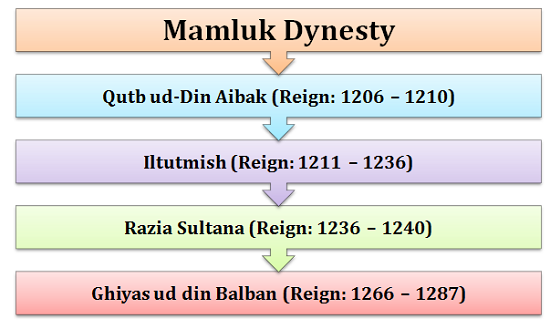

The Sultans of the Mamluk Dynasty who ruled in India were Qutb ud-Din Aibak (1206-1210 AD), Aram Shah (1210-1211 AD), Iltutmish (1211-1236 AD), Rukn-ud-din Feroze (1236 AD), Razia al-Din (1236-1240 AD), Muiz-ud-din Bahram (1240-1242 AD), Ala-ud-din Masud (1242-1246 AD), Nasiruddin Mahmud (1246-1266 AD), Ghiyas-ud-din Balban (1266-1286 AD) and Muiz-ud-din Muhammad Qaiqabad (1286-1290 AD). However, only Qutb ud-Din Aibak, Iltutmish, Razia al-Din and Ghiyas-ud-din Balban were the most deserving among these sultans.

Figure 1: Mamluk Dynasty
The Mamluks were the slaves that rose to the position of Sultans and maintained their dynasty for almost 300 years. They were the sultans of Delhi in the 13th century and because of their slave origin their dynasty is also known as the slave dynasty. The Mamluk period is divided into two periods according to historians, these are: Bahri (1250-1382) and Burji (1382-1517). These periods are divided as per the political dominance of the various regiments.
Qutb ud-Din Aibak was known to be the first king of this dynasty who was born into a Turkish family. He was sold to the ruler of the Ghor province in Afghanistan Muhammad Ghori as a slave. Due to his intelligence, he got promoted quickly and became the trusted general and commander of Muhammad Ghori. In 1192, he was given the responsibility to look after the Indian possessions of Ghori.
Aibak declared himself as the Sultan of Delhi after Ghori’s death in 1206. He started establishing the first Islamic monument in Delhi, Quwwat-ul-Islam and the monument is known to be one of the first Islamic monuments in north India. He also started building the famous Qutub Minar in Delhi. He was known as Lakh Bash meaning the giver of lakhs due to his generosity; however, he had brutally destroyed many Hindu temples. His reign ended with his death in 1210 as he died by a horse.
Aram Shah was the successor of Aibak, but he was not a strategic ruler. There is no proof that he was Aibak’s son or not but due to a conspiracy against himself he lost his right and Shamsuddin Iltutmish became the new ruler in 1211. He was previously the ruler of Ghurid regions of northern India and was Aibak’s son-in-law. He was known to be a Turkic slave born in Asia and the greatest slave ruler who shifted India’s capital from Lahore to Delhi. He conquered Bihar and Bengal in the year 1210 and 1225 respectively.
He conquered the Indus River Valley from 1228 to 1229 after dealing with Mongols and Khwarazm kings’. He secured his kingdom from Rajputs and Genghis khan. He completed building Quwwat-ul-Islam and Qutb Minar that was left by the Qutub-ud-Din Aibak (insightsonindia, 2022). He introduced tanka (silver coin) and jital (copper coin), the two Sultanates coins and introduced the Iqtadari system. He died in the year 1236 and the thorn went to his daughter Razia Sultana.
Razia Sultana became the successor of the thorn as Iltutmish consider her the most suitable for the thorn instead of his sons. She was born in the year 1205 and was educated by Iltutmish. She was known to be the first and last Muslim woman who ruled over Delhi and was also called Razia al-Din.
Her half-brother Rukn ud-din Firuz briefly ruled the kingdom before Razia sat on the throne. However, he got assassinated within 6 months and the nobles decided to make Razia the new queen. She started her reign in the year 1236 and was an efficient and just ruler. She married Bathinda’s governor Malik Ikhtiar-ud-din Altunia; however she got killed by her brother’s army and Muizuddin Bahram Shah became the new king.
The next notable king of the mamluk dynasty was its ninth Sultan Ghiyas ud din Balban. He was known to be the wazir of Iltutmish’s grandson Nasir-ud-din-Mahmud. His actual name was Bahauddin and was born in Turkish provinces. Iltutmish purchased him as a slave but he got promoted quickly as an officer and carried out various military campaigns. Balban chose himself as the king after Nasir died in 1266 as he had no male heirs.
Mamluk historians were known to be the biographers and prolific chroniclers and their ruling period is famous for its historical writings. They have also highly contributed to architecture by building schools, mosques, tombs, monasteries and many more. They had also made some abortive attempts toward socio-religious reformation.
The important aspects that led to this downfall were the following
There was some internal collision present among the members that led to the damage to the sultanate’s long-term integrity.
Not all rulers were notable and efficient and many of them were weak and could not maintain the decorum for long.
Due to this, a dysfunctional administrational management got created that later disrupted the government.
Mamluk Dynasty came to its downfall after its last ruler Muiz-ud-din Muhammad Qaiqabad failed to defeat Jalal ud din Firuz Khaliji. In 1516-17, the Mamluks were also got defeated in Egypt by the Ottomans. The Mamluk Dynasty ultimately got crushed but they maintained an influential power among the Egyptian people. The second last sultan of the Mamluk Dynasty, Ghiyas ud din Balban, was known to be the greatest sultan of India after Iltutmish and Allauddin Khalji.
Q1. What was the Iqtadari system?
Iqtadari system was introduced by one of the greatest sultans in India Iltutmish. This system divided the kingdom into Iqtas for the salary assignment of the nobles.
Q2. How was Ghiyas ud din Balban as a ruler?
Ghiyas-ud-din-Balban was a very strict ruler who made various punishments for the offender. He also kept a spy system to monitor the actions of his nobles.
Q3. What is Navroz?
It is a Persian festival that signifies the beginning of the Persian new year. Sultan Ghiyas ud din Balban first celebrated this occasion in India.